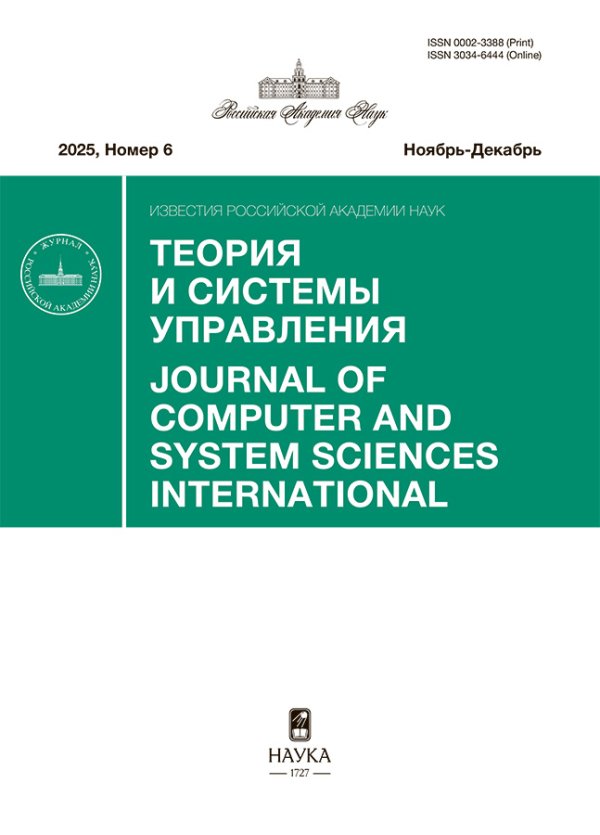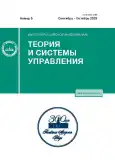БЫСТРОДЕЙСТВИЕ ГРУППЫ УПРАВЛЯЕМЫХ ОБЪЕКТОВ
- Авторы: Бортаковский А.С.1,2
-
Учреждения:
- Московский авиационный институт (национальный исследовательский ун-т)
- МИСиС (национальный исследовательский технологический ун-т)
- Выпуск: № 5 (2023)
- Страницы: 16-42
- Раздел: ОПТИМАЛЬНОЕ УПРАВЛЕНИЕ
- URL: https://journals.rcsi.science/0002-3388/article/view/140340
- DOI: https://doi.org/10.31857/S0002338823050049
- EDN: https://elibrary.ru/OECKJA
- ID: 140340
Цитировать
Полный текст
Аннотация
Рассматривается задача быстродействия группы управляемых объектов, начальное состояние каждого из которых задано, а конечное – выбирается из фиксированного набора возможных терминальных состояний (целей). Для каждого объекта требуется назначить цель и найти управление, обеспечивающее одновременное достижение группой всех выбранных целей за наименьшее время. Поскольку оптимальные по быстродействию управления отдельными объектами не решают задачу группового быстродействия, применяются так называемые минимально опаздывающие траектории. Разработана методика решения поставленной задачи, которая включает алгоритм решения минимаксной задачи назначения, процедуру использования оптимальных и минимально опаздывающих траекторий. Решена задача быстродействия группы объектов, плоское движение которых представляется траекториями Маркова–Дубинса.
Об авторах
А. С. Бортаковский
Московский авиационный институт (национальный исследовательский ун-т); МИСиС (национальный исследовательский технологический ун-т)
Автор, ответственный за переписку.
Email: asbortakov@mail.ru
Россия, Москва; Россия, Москва
Список литературы
- Каляев И.А., Гайдук А.Р., Капустян С.Г. Модели и алгоритмы коллективного управления в группах роботов. М.: Физматлит, 2009.
- Куржанский А.Б. Задача управления групповым движением. Общие соотношения // Докл. РАН. 2009. Т. 426. № 1. С. 20–25.
- Габасов Р., Дмитрук Н.М., Кириллова Ф.М. Оптимальное децентрализованное управление группой динамических объектов // ЖВМ и МФ. 2008. Т. 48. № 4. С. 593–600.
- Евдокименков В.Н., Красильщиков М.Н., Оркин С.Д. Управление смешанными группами пилотируемых и беспилотных летательных аппаратов в условиях единого информационно-управляющего поля. М.: Изд-во МАИ, 2015.
- Гончаренко В.И., Желтов С.Ю., Князь В.А., Лебедевa Г.Н., Михайлинa Д.А., Царева О.Ю. Интеллектуальная система планирования групповых действий беспилотных летательных аппаратов при наблюдении наземных мобильных объектов на заданной территории // Изв. РАН. ТиСУ. 2021. № 3. С. 39–56.
- Tsourdos A., White B., Shanmugavel M. Cooperative Path Planning of Unmanned Aerial Vehicles. N. Y.: Wiley&Sons, 2011.
- Jia Zeng, Xiaoke Yang, Lingyu Yang, Gongzhang Shen. Modeling for UAV Resource Scheduling Under Mission Synchronization // J. Systems Engineering and Electronics. 2010. V. 21. № 5. P. 821–826.
- Babel L. Coordinated Target Assignment and UAV Path Planning with Timing Constraints // J. Intelligent & Robotic Systems. 2019. V. 94 (3–4). P. 857–869.
- Бортаковский А.С., Щелчков К.А. Задачи группового быстродействия летательных аппаратов // Тр. МАИ. 2018. № 99. http://mai.ru//upload/iblock/33c/Bortakovskiy_ SHCHelchkov_rus.pdf.
- Poudel S., Moh S. Task Assignment Algorithms for Unmanned Aerial Vehicle Networks: A Comprehensive Survey // Vehicular Communications. 2022. V. 35. P. 100469.
- Бузиков М.Э., Галяев А.А. Перехват подвижной цели машиной Дубинса за кратчайшее время // АиТ. 2021. № 5. С. 3–19.
- Галяев А.А., Рубинович Е.Я. Планирование движения подвижных объектов в конфликтной среде // Аналитическая механика, устойчивость и управление: Тр. XI Междунар. Четаевской конф. (пленарные доклады). Казань: Изд-во КНИТУ-КАИ, 2017. С. 71–90.
- Mohsan S.A.H., Othman N.Q.H., Li Y. et al. Unmanned Aerial Vehicles (UAVs): Practical Aspects, Fpplications, Open Challenges, Security Issues, and Future Trends. Intel Serv Robotics. 2023. V. 16. P. 109–137.
- Марков А.А. Несколько примеров решения особого рода задач о наибольших и наименьших величинах // Сообщения Харьк. мат. общества. Сер. 2. Т. I. 1889. С. 250–276.
- Dubins L.E. On Curves of Minimal Length with a Constraint on Average Curvature, and with Prescribed Initial and Terminal Positions and Tangents // American. Mathematics. 1957. V. 79. № 3. P. 497–516.
- Isaacs R. Games of Pursuit // Scientific Report of the RAND Corporation. Santa Monica, 1951.
- Бортаковский А.С. Оптимальные по быстродействию траектории плоского движения с неограниченной кривизной // Изв. РАН. ТиСУ. 2022. № 4. С. 38–48.
- Пацко В.С., Федотов А.А. Трехмерное множество достижимости для машины Дубинса: сведение общего случая ограничений на повороты к каноническому // Изв. РАН. ТиСУ. 2023. № 4. С. 25–49.
- Диниц Е.А. О решении двух задач о назначении // Исследования по дискретной оптимизации. М.: Наука, 1976. С. 333–348.
- Глебов Н.И. Об одном обобщении минимаксной задачи о назначениях // Дискретн. анализ и исслед. операций. 2004. Т. 11. Вып. 4. С. 36–43.
- Серая О.В. Минимаксная задача назначения // Восточно-Европейский журнал передовых технологий. 2009. Т. 3. № 3(39). С. 8–11.
- Fulkerson D.R., Glicksberg I., Gross O. A Production Line Assignment Problem. Tech. Rep. RM-1102, The Rand Corporation. Santa Monica. CA, 1953.
- Burkard R., Dell’Amico M., Martello S. Assignment Problems: Revised Reprint. Siam, 2012. T. 125.
- Gottlieb Y.; Shima T. UAVs Task and Motion Planning in the Presence of Obstacles and Prioritized Targets // Sensors. 2015. V. 15. P. 29734–29764. https://doi.org/10.3390/s151129734
- Zhu X., Peng R. Optimal Routing, Aborting and Hitting Strategies of UAVs Executing Hitting the Targets Considering the Defense Range of Targets // Reliability Engineering and System Safety. 2021. V. 215. P. 107811.
- Кофман А., Анри-Лабордер А. Методы и модели исследования оптимизации. Целочисленное программирование. М.: Мир, 1976.
- Garfinkel R. An Improved Algorithm for the Bottleneck Assignment Problem // Oper. Res. 1971. V. 19. P. 1747–1751.
- Derigs U., Zimmermann U. An Augmenting Path Method for Solving Linear Bottleneck Assignment Problems // Computing. 1978. V. 19. P. 285–295.
- Федоренко Р.П. Приближенное решение задач оптимального управления. М.: Наука, 1978.
- Васильев Ф.П. Методы оптимизации. М.: Факториал Пресс, 2002.
- Понтрягин Л.С., Болтянский В.Г., Гамкрелидзе Р.В., Мищенко Е.Ф. Математическая теория оптимальных процессов. М.: Физматгиз, 1961.
- Грачев Н.И., Евтушенко Ю.Г. Библиотека программ для решения задач оптимального управления // ЖВМ и МФ. 1979. Т.10. № 2. С. 367−387.
- Cockayne E.J., Hall G.W.C. Plane Motion of a Particle Subject to Curvature Constraints // SIAM J. Control and Optimization. 1975. V. 13. № 1. P. 197−220.
- Ли Э.Б., Маркус Л. Основы теории оптимального управления. М.: Наука, 1972.
- Иоффе А.Д., Тихомиров В.М. Теория экстремальных задач. М.: Наука, 1974.
- Поляк Б.Т. Введение в оптимизацию. М.: Наука, 1983.
- Кларк Ф. Оптимизация и негладкий анализ. М.: Наука, 1988.
Дополнительные файлы






























